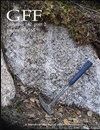立陶宛结晶基底中约1.83 Ga的晶闪石-紫青石片岩告诉我们东欧克拉通晚古元古代的增生过程
IF 1.2
4区 地球科学
Q2 GEOLOGY
引用次数: 5
摘要
摘要:在立陶宛南部的西欧-东欧火山口(EEC),一套成分异常的细粒、薄层岩石已被证明最初由中英质和长英质火山岩组成。它们在约1.83 Ga时挤压,并在变质作用前发生水热蚀变,变质作用将它们转化为含石榴石、硬石膏、花千枚岩、十字石和堇青石的片岩。岩石经历630°C和7 kbar变质作用后,可能在约1.73 Ga时被抬升至15 km(5 kbar)。在约1.50 Ga(独居石年龄)时被重新加热至640°C。约1.50 Ga的独居石年龄与相邻的1.50 Ga Anorthosite Mangerite-Charnokite Granite(AMCG)Mazury杂岩的侵位同时代。立陶宛和波兰北部约1.83 Ga的火山岩套,以及瑞典中南部的Oskarshamn-Jönköping带(OJB),可能属于同一火山岛弧链,从而提供了整个欧洲经济共同体西部演化的信息。约1.50 Ga的变质改造和Mazury AMCG岩套的替换可能是由更西部的达诺波隆造山运动引发的,在更大范围内,哥伦比亚大陆边缘的吸积。本文章由计算机程序翻译,如有差异,请以英文原文为准。
What the ca. 1.83 Ga gedrite-cordierite schists in the crystalline basement of Lithuania tell us about the late Palaeoproterozoic accretion of the East European Craton
ABSTRACT In the western East European Craton (EEC), southern Lithuania, a suite of fine-grained, thinly bedded rocks of unusual composition has been shown to have originally comprised intermediate and felsic volcanic rocks. They extruded at ca. 1.83 Ga and were hydrothermally altered prior to metamorphism, which converted them into garnet-, gedrite-, anthophyllite-, staurolite- and cordierite-bearing schists. After the rocks have experienced a 630°C and 7 kbar metamorphism, they were uplifted to 15 km (5 kbar) probably at ca. 1.73 Ga. They were reheated to 640°C at ca. 1.50 Ga (monazite age). The monazite age of ca. 1.50 Ga is coeval with the emplacement of the neighboring 1.50 Ga Anorthosite-Mangerite-Charnockite-Granite (AMCG) Mazury complex. The ca. 1.83 Ga volcanic suites in Lithuania and northern Poland, together with the Oskarshamn-Jönköping belt (OJB) in south-central Sweden, may belong to the same chain of volcanic island arcs, and thus provide information on the evolution of the entire western EEC. The ca. 1.50 Ga metamorphic reworking and the replacement of the Mazury AMCG suite may have been triggered by the Danopolonian orogeny further west and, at a larger scale, accretion of the continental margin of Columbia.
求助全文
通过发布文献求助,成功后即可免费获取论文全文。
去求助
来源期刊

Gff
地学-地质学
CiteScore
2.80
自引率
10.00%
发文量
11
审稿时长
>12 weeks
期刊介绍:
GFF is the journal of the Geological Society of Sweden. It is an international scientific journal that publishes papers in English covering the whole field of geology and palaeontology, i.e. petrology, mineralogy, stratigraphy, systematic palaeontology, palaeogeography, historical geology and Quaternary geology. Systematic descriptions of fossils, minerals and rocks are an important part of GFF''s publishing record. Papers on regional or local geology should deal with Balto-Scandian or Northern European geology, or with geologically related areas. Papers on geophysics, geochemistry, biogeochemistry, climatology and hydrology should have a geological context. Descriptions of new methods (analytical, instrumental or numerical), should be relevant to the broad scope of the journal. Review articles are welcome, and may be solicited occasionally. Thematic issues are also possible.
 求助内容:
求助内容: 应助结果提醒方式:
应助结果提醒方式:


